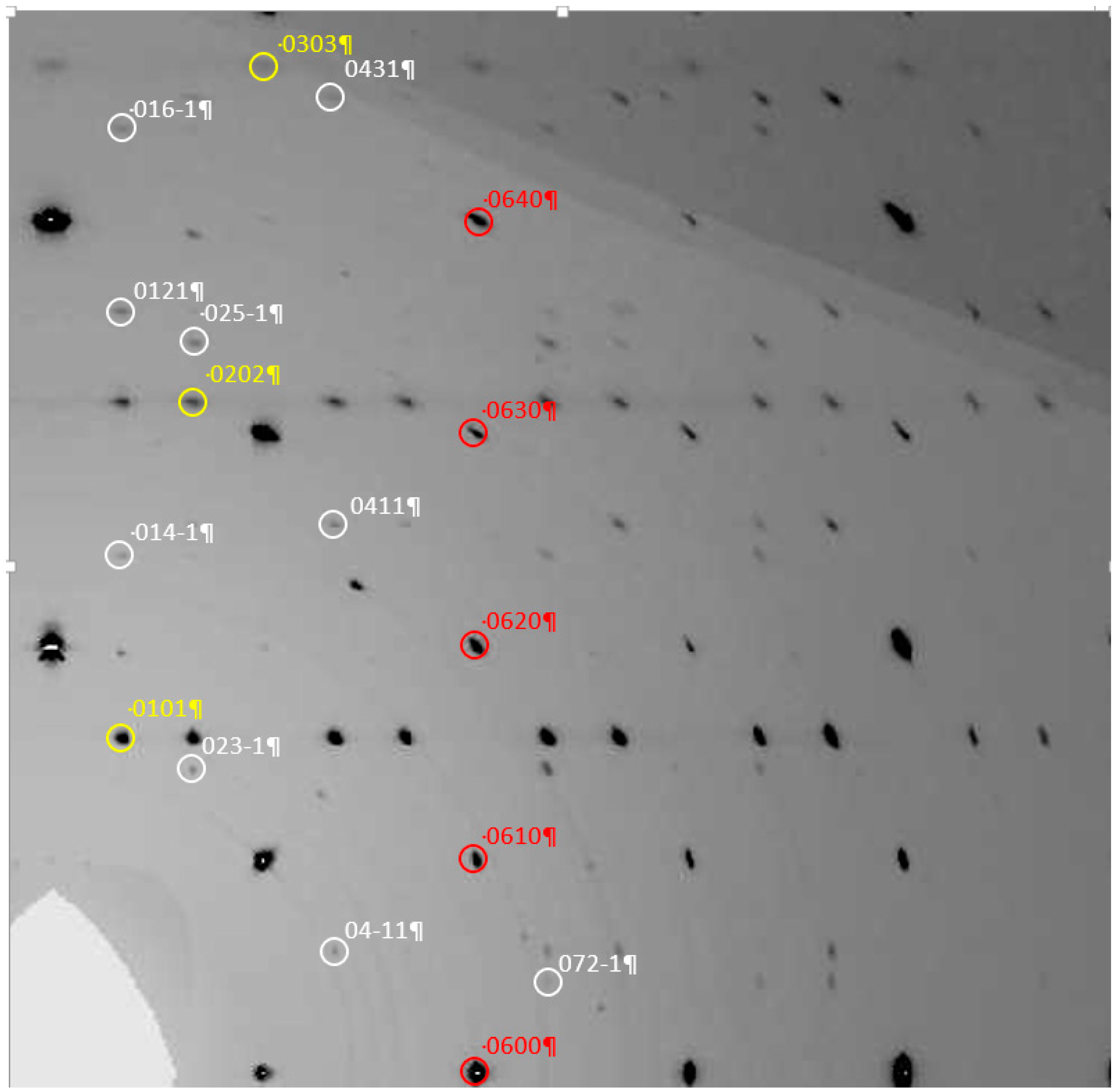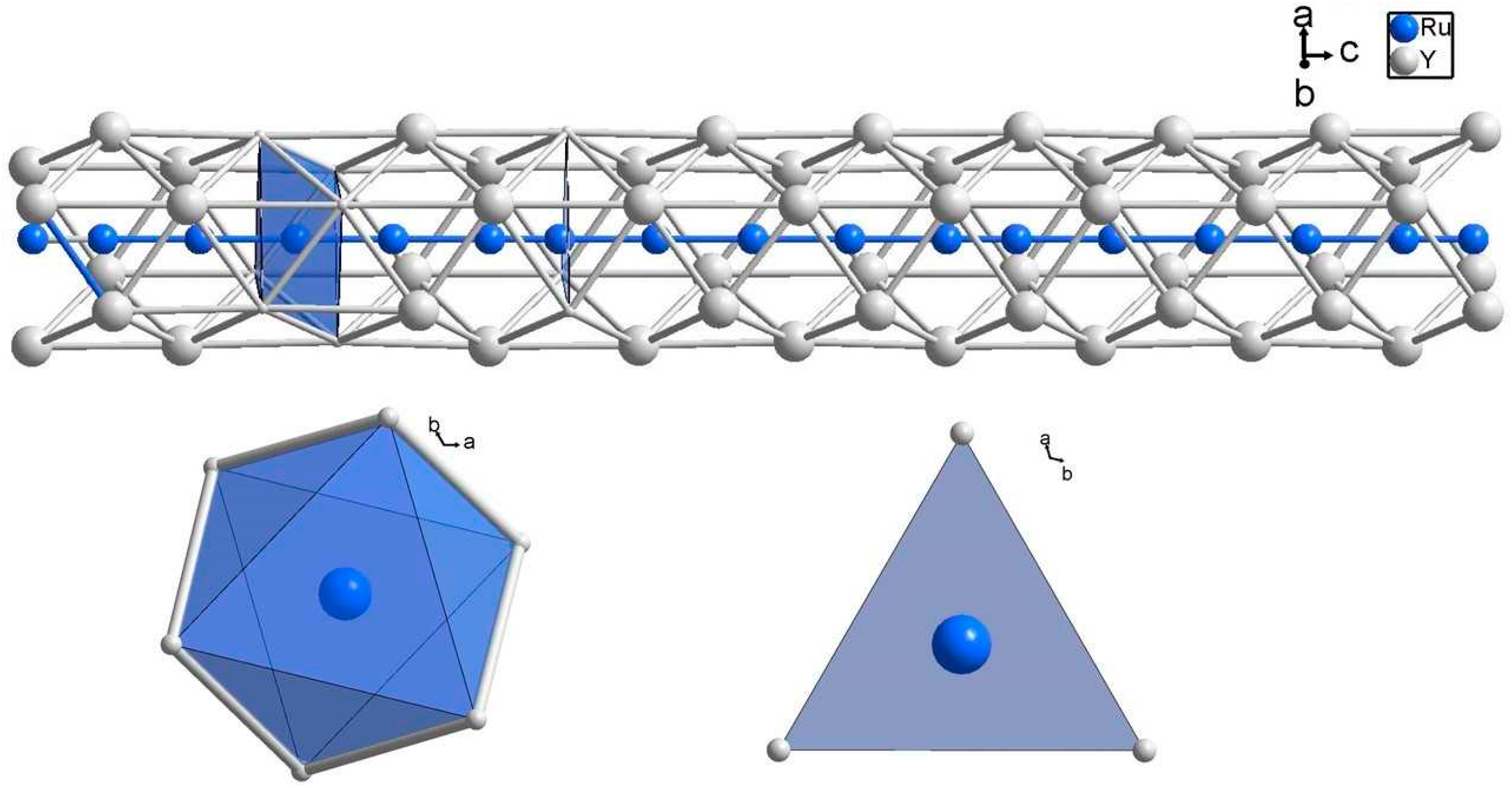2. Materials and Methods
Ruthenium shot (99.9%, ABCR) was degassed according to the procedure described by Palenzona and Canepa [
1] and pressed into pellets together with a small superstoichiometry of yttrium (99.9%, STREM). The pellets were homogenized by repeated arc-melting. Weighing the resulting ingot revealed a slight loss of Y due to vaporization and the over-all composition changed from the nominal 36% Ru to 38% Ru. After sealing the ingot in an evacuated silica ampoule, it was annealed at 770 °C for 12 days. The challenge in the synthesis is to achieve a relatively homogeneous sample with high melting Ru (melting point 2334 °C) without significant loss of the volatile Y (melting point 1523 °C). This is a challenge for all binary Ru-Y compounds, but in particular for the relatively low melting Y
3Ru
2−x, that additionally has a very close companion in Y
44Ru
25. Since the real composition of Y
3Ru
2−x is Y
3Ru
1.787 (62.7% Y), the difference to Y
44Ru
25 (65.7%) is indeed small and balancing the Y content with evaporation is finicky business. Crushing the ingot yielded a Y
3Ru
2−x single crystal of good quality, but the sample also contained Y
44Ru
25 and traces of the high melting YRu
2 (melting point 1950 °C). Interestingly, the compositionally close Y
44Ru
25 is also a composite structure, but structurally very different from Y
3Ru
2−x.
The single crystal was mounted on a glass fibre and a first X-ray experiment on in-house equipment (XCaliburE, Oxford diffraction) exhibited a diffraction pattern with clear incommensurate satellites. The number of these was however limited and therefore the sample was taken to the synchrotron Soleil, where a measurement was carried out at the beamline Cristal.
Single crystal data were collected using radiation of the wavelength λ = 0.42484 Å in a single 360° scan with the detector set at an angle of 30°. The unit cell was found to have the parameters
a= 7.9986(5) Å,
c = 3.9840(3) Å, in excellent agreement with reported data [
1] (a = 8.004,
c = 3.998) and a
q vector given by
q = (1/3 1/3 γ), γ = 0.4276(7). A second
q vector
q2 = (2/3 2/3 γ) indicates that the structure most likely is twinned and diffuse scattering was discernible, forming planes perpendicular to
c* and enveloping the strong first order satellites (conf
Figure 1). Second order satellites were clearly discernible, but on integration, few were above a 3σ threshold, therefore second order satellites were not used in the refinement (confer
Table 1).
For the final treatment of the data, integration was carried out in the augmented unit cell a = 13.842 c = 3.9855 and an axial q-vector,
q = (0 0 γ), γ = 1.574. In this cell, the following 3 + 1 dimensional extinction condition applies:
hklm, h − k + m = 3n, which is compatible with the centring vectors (1/3 2/3 0 1/3) and (2/3 1/3 0 2/3). The intensity distribution of the satellites indicates that a composite structure is probable, and the structural solution supports this, placing one Ru position and one Y position in the original unit cell and a second Ru position in a unit cell given by the transformation matrix
W. Since reflections of the type
hklm with both
l and
m being non-zero are observable, there is data to support intersystem modulation.
This yields a second unit cell with the c′ parameter 2.5321 Å and the q′ vector γ component γ = 0.6353.
The structure was solved by charge flipping [
4] in superspace, as implemented in JANA2006 [
5]. Three atomic positions were easily identified and one of them was clearly best described as a second component of the structure. Refinement progressed smoothly and convergence was achieved for a model using first order harmonic modulations for the positional parameters of all atoms. Introduction of anisotropic displacement parameters led to strong correlations between the modulation parameters and displacement parameters for the single atom in the second composite cell, Ru2. The atomic positions in the first composite cell, Y1 and Ru1, were stable and essentially spherical. In the final refinement, the displacement parameters for Ru2 were left as isotropic. Final agreement parameters R
1 for the converged model were 0.029 for 532 independent, observed, main reflections and 0.096 for 2332 first order satellites in a model with 24 refined parameters. The twin ratio was refined to slightly less than 50% for the individual for which satellite data was used. Conversely the merging R-values for trigonal and hexagonal symmetry were indistinguishable, indicating that the volume of both possible rhombohedral individuals (obverse/reverse) should be equal. Using a smaller twin ratio for the modulated twin is corroborated by the observation of diffuse scattering perpendicular to the
c*-axis. Satellites being replaced by diffuse scattering may be interpreted as proof of the presence of a significant number of regions in the crystal where no correlation between the first and second composite part can be found. All structural figures in the paper were prepared using the software Diamond [
6].
3. Discussion
The amplitudes of the positional modulations are small, and hence the structure is essentially that described by Fornasini and Palenzona [
2], with the exception of Ru2, which is perfectly ordered in the present model. In
Figure 2, the backbone of the structure, the first subcell, is shown. Ru1 atoms centre tri-capped trigonal prisms of Y1 and these polyhedra share faces and edges to form a network with hexagonal tunnels running along the
c-direction of the trigonal cell. In the centre of the hexagonal tunnels reside the Ru2 atoms that have a different repeat along
c. This causes a continuously changing environment for the Ru2 atoms, shifting between planar trigonal coordination and octahedral coordination. This is shown in
Figure 3.
In
Figure 4, the variation in bond distances in shown. The slight modulation serves to even out the small differences in coordination caused by the composite nature of the structure.
The overall composition of the single crystal is Y3Ru1.79 as defined by the unit cell and the q-vector. The content of the first sub cell is Y18Ru6, while that of the second subcell is Ru3. Since the ratio between the sub cell volumes is given by the ratio of the c-axes, and the second sub cell hence is 1.572 times smaller (and consequently denser), the combined cell content is given by Y18Ru6 + 1.572* Ru3 = Y18Ru10.72. The difference in electronegativity between Y and Ru is close to unity and the compound must be considered to be polar, albeit not strongly so.









